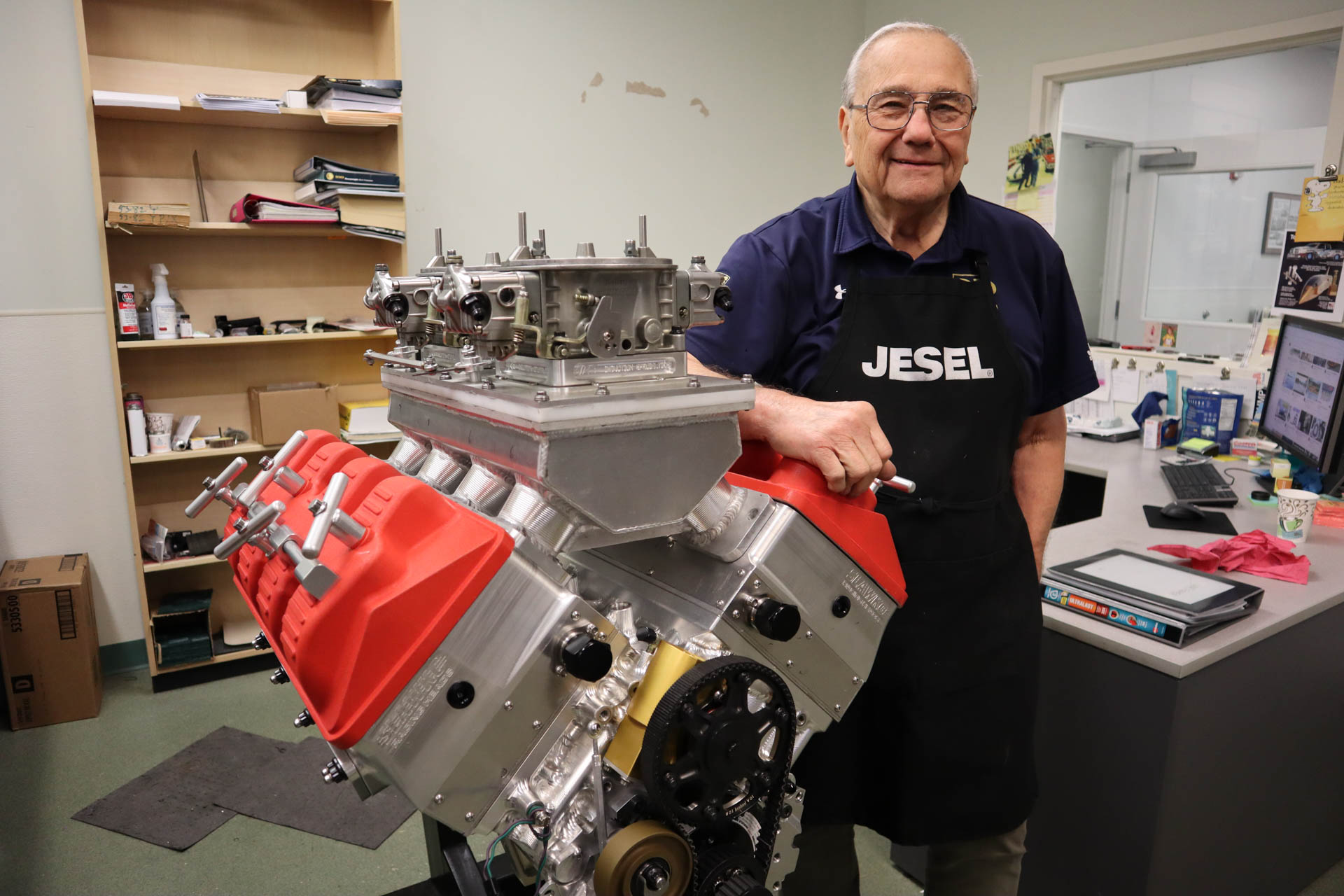Dan Jesel, founder of Jesel Valvetrain Innovation, passed away Jan. 10. He was 81.

https://www.nmradigi...all-out-v8/1926
Dan Jesel Developed A Unique V8 Engine From Scratch
By Evan J. Smith
Photography by the author and courtesy of Jesel
It’s likely you’ve heard the sad news about the passing of Dan Jesel, owner of Jesel Valve Train Innovation. For many decades Dan and his team created innovation that helps racers make maximum power in a reliable fashion. Rockers, lifters and belt-drives are the most common components, but over the last few years, Dan worked on a special project, one he dubbed the Equal Eight. It's a V8 engine that he designed from scratch, and with the help of some very smart individuals, it was built, tested and raced.
Dan Jesel used his decades of experience to converge on an idea that the perfect V8 would have eight equal cylinders free of compromise. If you think about it, virtually all production-based engines are subject to some form of compromise due to manufacturing cost, space limitations or emissions. Mechanically, area that cause problems are unequal length intake runners, non-perfect valvetrain configuration, cooling that favors certain cylinders, fuel flow, and even oiling.
Many racers think in overall power. “My engine makes 800 horsepower.” That’ a common statement, however, each of the eight cylinders is not producing exactly 100 horsepower. In fact, despite a builder or tuner’s best efforts, cylinder-to-cylinder output can vary—sometimes by a sizeable percentage.
The inequalities are due to inefficiencies in the induction system, valve timing and/or mechanical imperfections including results from windage, lifters dragging in the bore and parasitic loss, all which rob power. Some of these issues can be rectified with aftermarket blocks, heads, valve train pieces and other modifications, however, the vast majority of drag racing engines rely on factory architecture, so you’re stuck with OE port configurations, stock bore spacing, imperfect oiling, and at times, inadequate cylinder head retention.
Stock configurations were not an issue for Jesel, as the Equal Eight is just that, equal from cylinder to cylinder. Jesel initially decided on building his masterpiece as a 427-cube version to make a direct power comparison to the Chevrolet L88, 426-cube Hemi and Ford 427-, 428- and 429-displacement engines from the muscle-car era, along with the modern LS7. His target was 1,300 horsepower, or 3.1 hp per cubic inch.
The Equal Eight ran for the first time in Larry Morgan’s B/Altered Comp entry at the 2021 NHRA U.S. Nationals in Indy. Morgan ran 7.13 at 194 mph with the 441-cube Equal 8 engine, which only saw a few pulls on the dyno previously. Output was just under 1,300 horsepower at 10,000-plus rpm! ...
...Stay Cool
Jesel understood the importance of cooling, as temperatures must be equalized from cylinder to cylinder to make equal power. If a cylinder is hotter than the rest, it won’t tolerate as much timing and this will hurt power. So, he used billet aluminum cooling manifolds that attach to the block and feed water to the exhaust side of the head first, before moving through the rest of the head and the block. In all, the Equal 8 is a well-though-out internal combustion engine that’s racer friendly and makes great power.
What’s most impressive is the Equal 8 made 1,282.1 horsepower at 10,200 rpm and you’ll note it was still climbing when they cut the pull. This was during the first dyno session, with very little run time. Jesel commented that peak power was likely to be higher, but the point was proven and it was time to get the engine off the dyno and into Larry Morgan’s car for real-world testing.
“After spending that much time, it was rewarding to hear it run,” said Dan Jesel, “And we really got to that point fairly quick. Now when it goes back on [the dyno] we have a different cam and collectors and that’s about it,” he said. “I’m not going to do much more, I’ll just do the other motors. It should be in the hands of racers and engine builders. I mean, I’m not claiming I’m an engine builder. I designed the block and the configuration. I just figured engines this big don’t get close to 10,000, but we went to 10,400 and it didn’t fall off, and that’s pretty exciting.”
Equal 8 Engine Specifications
Block: Aluminum 90-degree V8 Wet Sleeve
Bore: 4.500-inches
Stroke: 3.470-inches
Displacement: 441 cubic inches
Deck Height: 8.50-inches
Cam Journals: 1.687-inches
Main Journals: 2.560-inches
Crankshaft: Winberg Billet Steel
Connecting rods: Steel
Rod Journals: 1.850-inches
Camshaft: Lift 1.100-inch; Exhaust 1.0-inch/Duration 289-degrees intake; 304-degrees exhaust
Cam Drive: External Jesel Belt Drive
Cylinder Heads: Slawko Racing Billet Aluminum
Valves: Intake 2.400-inches, 9-degree angle with 3-degree cant; Exhaust 1.720-inches -2-degree angle, 1.5-degree cant
Rockers: Jesel Pro Steel, Intake 1.95:1 Exhaust 1.90:1
Compression Ratio: 16:1
Pushrods: Intake 7.5-inches Exhaust 8.7-inches
Horsepower: 1,285 at 12,200 rpm
Torque: 713 @ 8,500 rpm
Redline: 12,500 rpm











